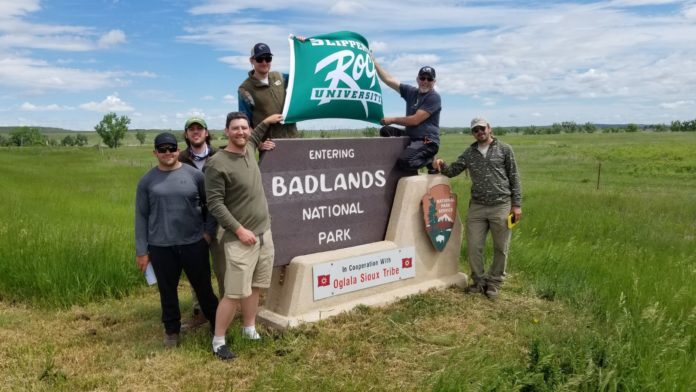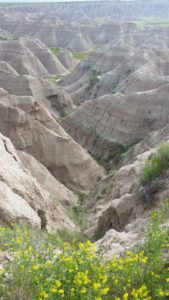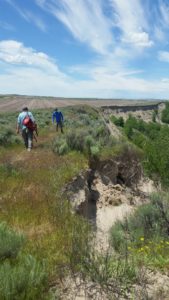
Five SRU students joined Patrick Burkhart, an associate professor of geography, geology and the environment (GGE), in his research pertaining to changing weather patterns through the study of the potential geochemical relationship between the White River Badlands (WRB) and the Nebraska Sand Hills (NSH).
Burkhart would invite senior geology students Colton Byers, Brett McClinton, Ellis Peet, Cody Brown, a spring 2020 environmental geoscience and geography graduate, and Henry Kramer, a spring 2019 environmental geoscience graduate, for the summer of 2019.
They would also be joined by Paul Baldauf, a professor of environmental science and studies at Nova Southeastern University of Florida, and Gregory Baker, an associate professor of geology at Colorado Mesa University.
Jack Livingston, an associate professor of geography, geology and the environment who has traveled to the area in years past, but stayed behind during 2019’s expedition, offered support in the management and analysis of collected geospatial data.
Their research would involve traveling to Badlands National Park in South Dakota and to the NSH, a “sahara” of the western hemisphere as it extends approximately 200 miles from East to West and 150 miles North to South.

“Not only is it a beautiful region, but the longer you look at that landscape, the more confusing it gets,” said Peet. “When doing research there, you always seem to take one step forward, but then two steps backward because the landscape is crazy and there are so many questions that need to be answered about it… You have to piece together where the sediments came from and where they go and in what order.”
Brown, Byers, Kramer, McClinton and Peet would help Burkhart collect soil samples in the WRB and NSH regions to be analyzed later to better understand the NSH’s chemical makeup. This would provide supporting evidence as to whether or not the NSH’s sediments mostly originate from the WRB.
These samples would help improve the accuracy of previous data, especially as the team would utilize laser-induced breakdown spectroscopy (LIBS) technology, optical emission spectroscopy used to measure elemental concentrations in a material.
“The big key thing to what we’re doing is using laser-induced breakdown spectroscopy to try to chemically analyze the sands,” said McClinton. “It is actually a gun that the GGE department owns.”
Through help from a representative of the gun’s original maker, SciApps, the GGE department’s gun would be given “standards,” or programming that tells the device what it should be seeing to identify each individual element. Though, “you have to have an idea of what you are looking for ahead of time,” said McClinton.
Upon analysis, the samples’ chemical makeup would vary depending on whether the sample was taken closer to the parent material of the WRB or the ending destination of the NSH. This would include the lack of heavy metals such as aluminum, calcium and manganese in NSH samples.
The presence or lack of these elements along with other “maturity” signals such as the roundness and assortedness of sediments would help reflect the maturation of sand as it potentially traveled from the WRB to the NSH. Though, additional sampling and research will be necessary to make official connections between the two areas.
Burkhart’s research of the relationship between the WRB and NSH is only a small part of a larger research interest of his that he has been pursuing since 1999: studying earth’s previous weather patterns.
“The past can help us understand the context of the present,” said Burkhart.
Burkhart, Baldauf and Baker believe they can reconstruct ancient weather patterns through the Badlands due to the influence of previous extreme weather events on the area.
Previous weather events include the Medieval Climate Anomaly (MCA), a short period of extreme warming from approximately 950 c.e. to 1200 c.e., and the Little Ice Age (LIA), a short period of extreme temperature decrease from approximately 1400 c.e to 1500 c.e.

Studying the evidence left behind by these events helps to identify potential dangers that might arise as our current climate is changing once again.
“The [MCA] and [LIA] events both produced mega-droughts, droughts that lasted for decades. So part of the concern is understanding what has occurred here because if we go into another drought, it would be disastrous,” said Burkhart.
Burkhart would further link these droughts to other natural threats such as rampant wildfires- similar to the ones already seen in California- that would severely threaten industries such as agriculture.
By also piecing together the landscape, the team also hopes to better understand the causality of aridity.
“If we’re able to see if the [NSH] was from a certain time period from the Badlands, you can see what kinds of climate patterns mobilize the creation of dunes,” said Byers.
Despite halts in traveling due to the COVID-19 Pandemic, which canceled the 2020 summer trip, Burkhart is hopeful that by the summer of 2021, he along with Livingston, Baldauf, Baker and another group of students will be able to return to continue exploration and research.






